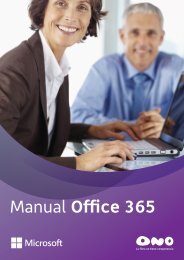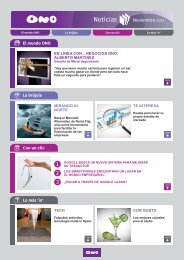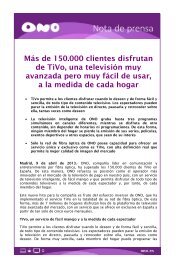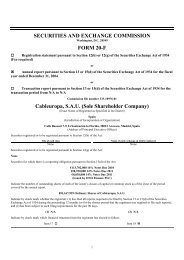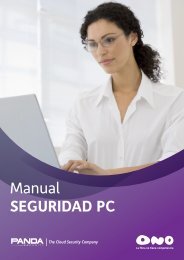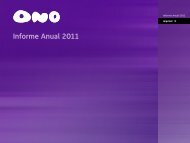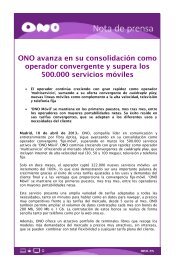Annual Report 2012 - Ono
Annual Report 2012 - Ono
Annual Report 2012 - Ono
You also want an ePaper? Increase the reach of your titles
YUMPU automatically turns print PDFs into web optimized ePapers that Google loves.
ONO’s Responsibility<br />
Commitment to stakeholders | Suppliers<br />
Principles of action:<br />
Certification of suppliers<br />
Procurement desk<br />
ONO in <strong>2012</strong><br />
- Ensure their compliance with the laws<br />
and regulations applicable to the sector<br />
they operate in and their country of origin.<br />
- Respect human rights, regardless<br />
of race, gender, age, nationality, sexual<br />
orientation or political or religious beliefs.<br />
- To act in accordance with protection of<br />
the environment, minimizing the generation<br />
of pollutants, and applying policies for<br />
recycling and waste management.<br />
- To monitor employment of labour,<br />
ensuring that minors are not hired, that<br />
work is not coercive, threatening, or<br />
abusive, and that policies for health and<br />
safety at the workplace and the prevention<br />
of risks are followed.<br />
- Maintain a high level of business<br />
ethics, expressly forbidding any payment<br />
of commissions, bribes, ostentatious<br />
gifts, or any other element that could<br />
significantly influence decision making in<br />
the purchasing process.<br />
Currently, more than 1,000 suppliers have<br />
signed this document, or 23% of the total<br />
supplier base, and a process has been<br />
established for any supplier who participates<br />
in a tender to understand and accept these<br />
basic principles. With this Code of Conduct,<br />
ONO aims to guarantee that its main suppliers<br />
respect basic human rights principles.<br />
The process described above forms an<br />
additional element of the more wide<br />
reaching process of supplier certification.<br />
ONO wants to know who its suppliers are,<br />
and what differentiates them from the<br />
others. To this end, five years ago, it started<br />
this process.<br />
To implement this process, suppliers are<br />
requested to fill in a self-assessment<br />
form, providing information on their<br />
shareholders, finances, resources,<br />
processes, possible relationships<br />
with management personnel of ONO,<br />
certifications they may possess from<br />
organisations. etc., which will allow the<br />
purchasing department to weight the<br />
scoring of the adjudication processes and<br />
act as transparently and objectively as<br />
possible.<br />
Thanks to the implementation of this<br />
process, over 800 suppliers have been<br />
assessed, using the process as a condition<br />
and as a filter for being able to participate<br />
in new negotiations and procurement<br />
processes.<br />
In addition, in some important cases,<br />
systems to measure service delivery are put<br />
in jointly by purchasing and the user areas,<br />
to monitor the quality and level of service,<br />
provide an opportunity to correct problems<br />
or to support a change in suppliers.<br />
ONO’s business model for Purchasing,<br />
implemented in 2011, is based on a system<br />
of “desks” in which all the areas involved<br />
in a transaction work together to assess<br />
and decide on the best solution for a<br />
purchasing need at ONO. This model also<br />
integrates internal policies for monitoring<br />
and supervising these decisions, the main<br />
principles of which include:<br />
- Guaranteeing that competition is used<br />
in all the cases where it is possible, or<br />
analysing the circumstances in which it is<br />
appropriate to renew existing suppliers.<br />
- Ensuring the highest level of<br />
transparency with all internal participants, to<br />
guarantee equal opportunities for external<br />
participants (suppliers or potential suppliers).<br />
- Looking for new alternatives to existing<br />
solutions and constantly analysing different<br />
alternatives and solutions that could help<br />
the Company meet its requirements more<br />
efficiently and economically.<br />
- Monitoring the compliance with the<br />
Company’s budgets, and the consolidation<br />
of savings achieved in negotiations for<br />
their possible reinvestment subsequently,<br />
or transfer to the P&L.<br />
In January 2013, the Purchasing department<br />
partly modified the model to provide more<br />
flexibility and better meet its requirements.<br />
The revised model clarifies the scope of its<br />
application.<br />
Who is ONO?<br />
What does ONO do?<br />
ONO’s<br />
Responsibility<br />
Corporate<br />
Responsibility Focus<br />
Commitment to<br />
stakeholders:<br />
1. Shareholders<br />
and Investors<br />
2. Customers<br />
3. Employees<br />
4. Suppliers<br />
5. Media<br />
6. Society<br />
Financial analysis<br />
Corporate<br />
Governance <strong>Report</strong><br />
The Figures<br />
Annexes<br />
Contact<br />
Information<br />
Print<br />
<strong>Report</strong><br />
The Figures<br />
95



